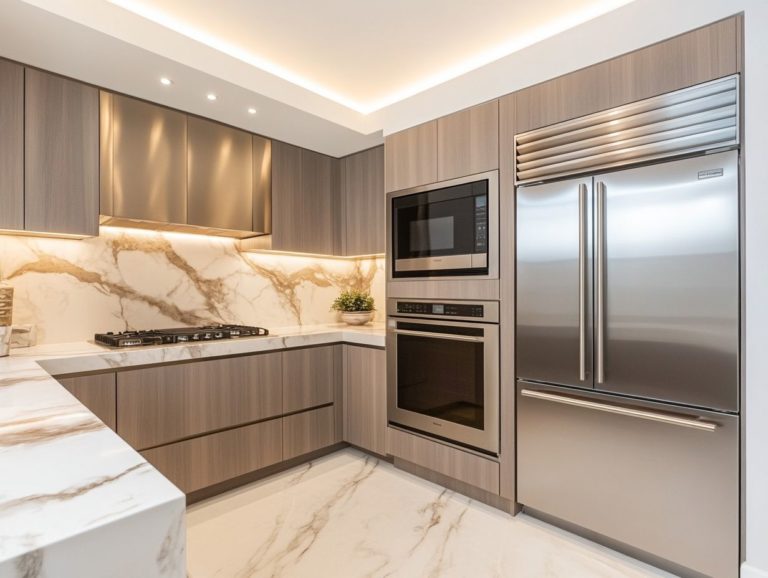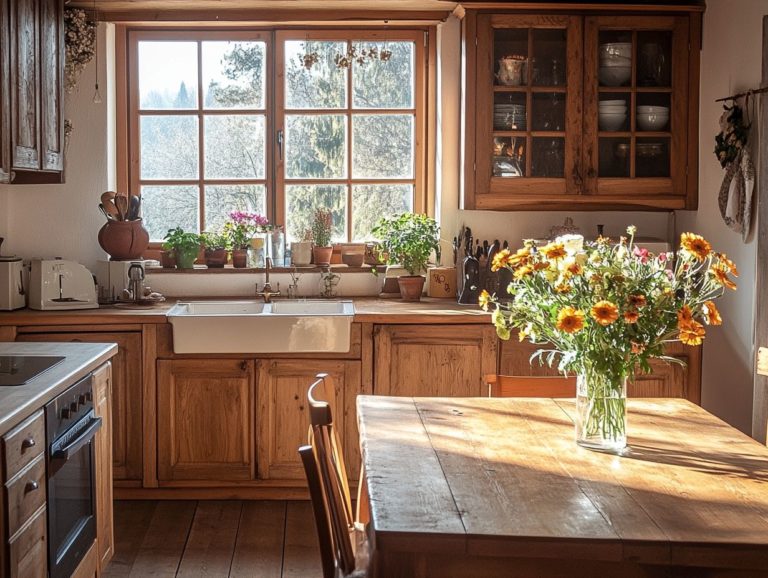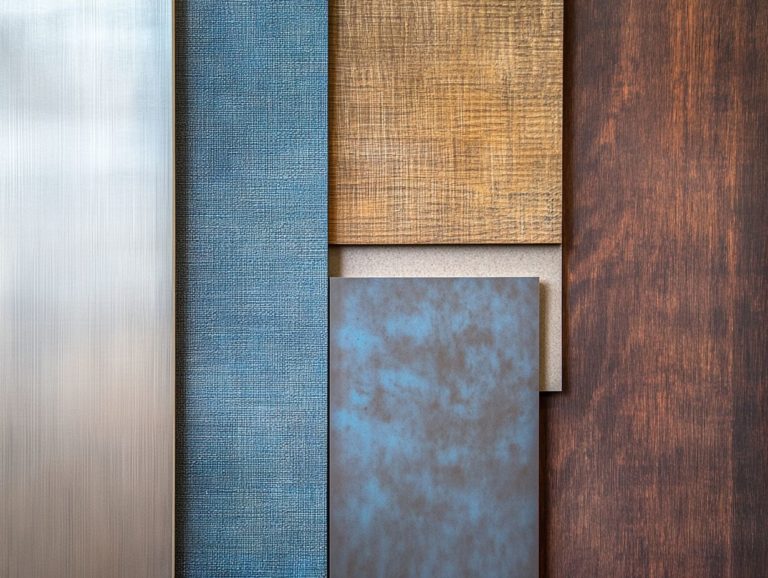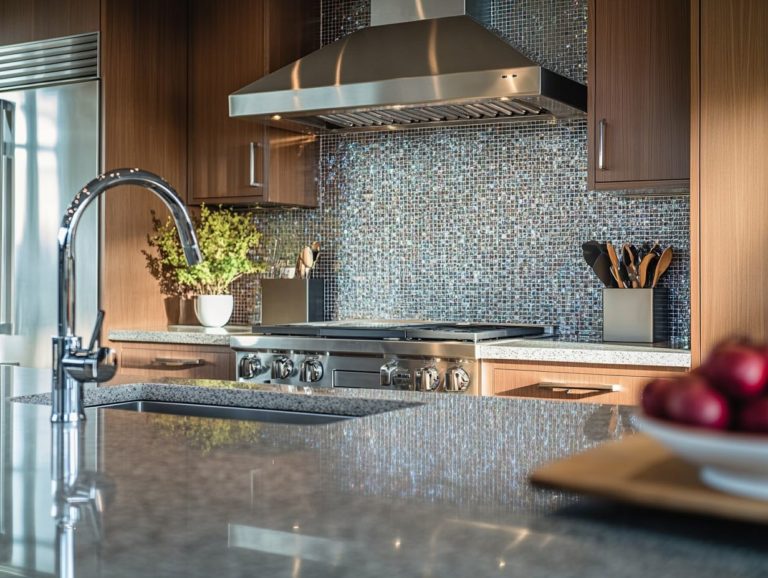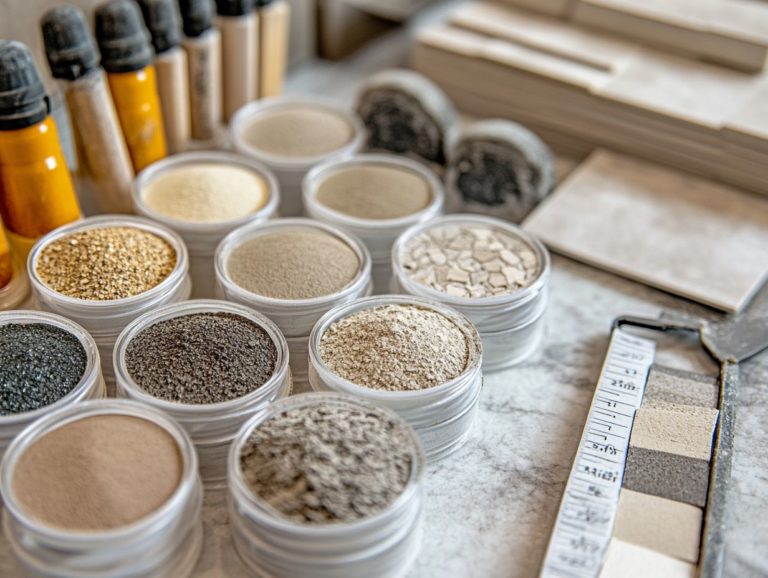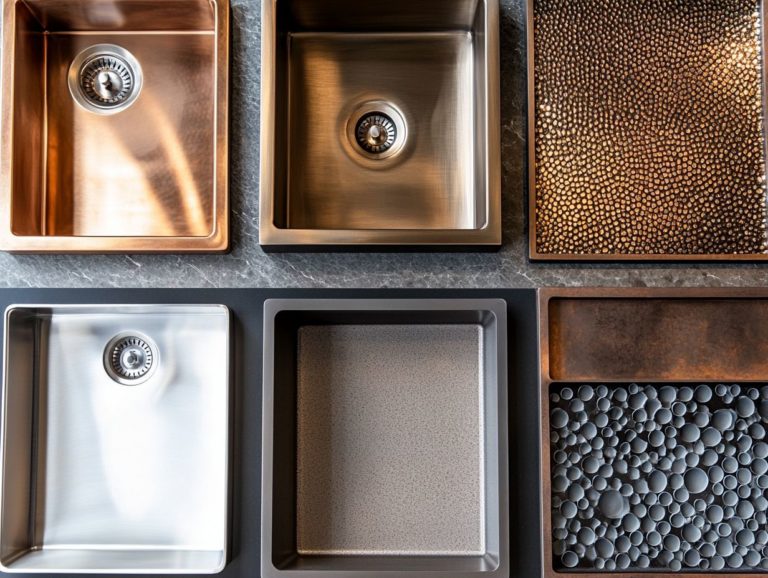5 Unconventional Materials for Kitchen Design
Are you prepared to elevate your kitchen into a realm that harmonizes functionality with undeniable character?
In a landscape often dominated by conventional materials, venturing into unconventional options can unleash a world of creativity and sustainability in your design approach.
From the bold appeal of striking concrete to the inviting warmth of reclaimed wood, this article delves into five distinctive materials that can enhance the look and function of your kitchen.
Discover the benefits, potential drawbacks, and insightful tips for seamlessly integrating these elements into your space. Get ready to be inspired to craft a kitchen that genuinely mirrors your unique style!
Contents
- Key Takeaways:
- 1. Concrete
- 2. Recycled Glass
- 3. Reclaimed Wood
- 4. Stainless Steel
- 5. Cork
- Why Should You Consider Using Unconventional Materials in Your Kitchen?
- What Are the Benefits of Using These Materials?
- What Are the Potential Drawbacks of Using These Materials?
- How Can These Materials Add Unique Design Elements to Your Kitchen?
- What Are Some Tips for Incorporating These Materials into Your Kitchen Design?
- What Are Some Examples of Kitchens Using These Unconventional Materials?
- Frequently Asked Questions
- What are some of the unconventional materials used in kitchen design?
- How can concrete be used in kitchen design?
- What makes reclaimed wood a unique material for kitchen design?
- In what ways can metal be incorporated into kitchen design?
- How can glass be used in a kitchen design?
- What makes cork a suitable material for kitchen design?
Key Takeaways:
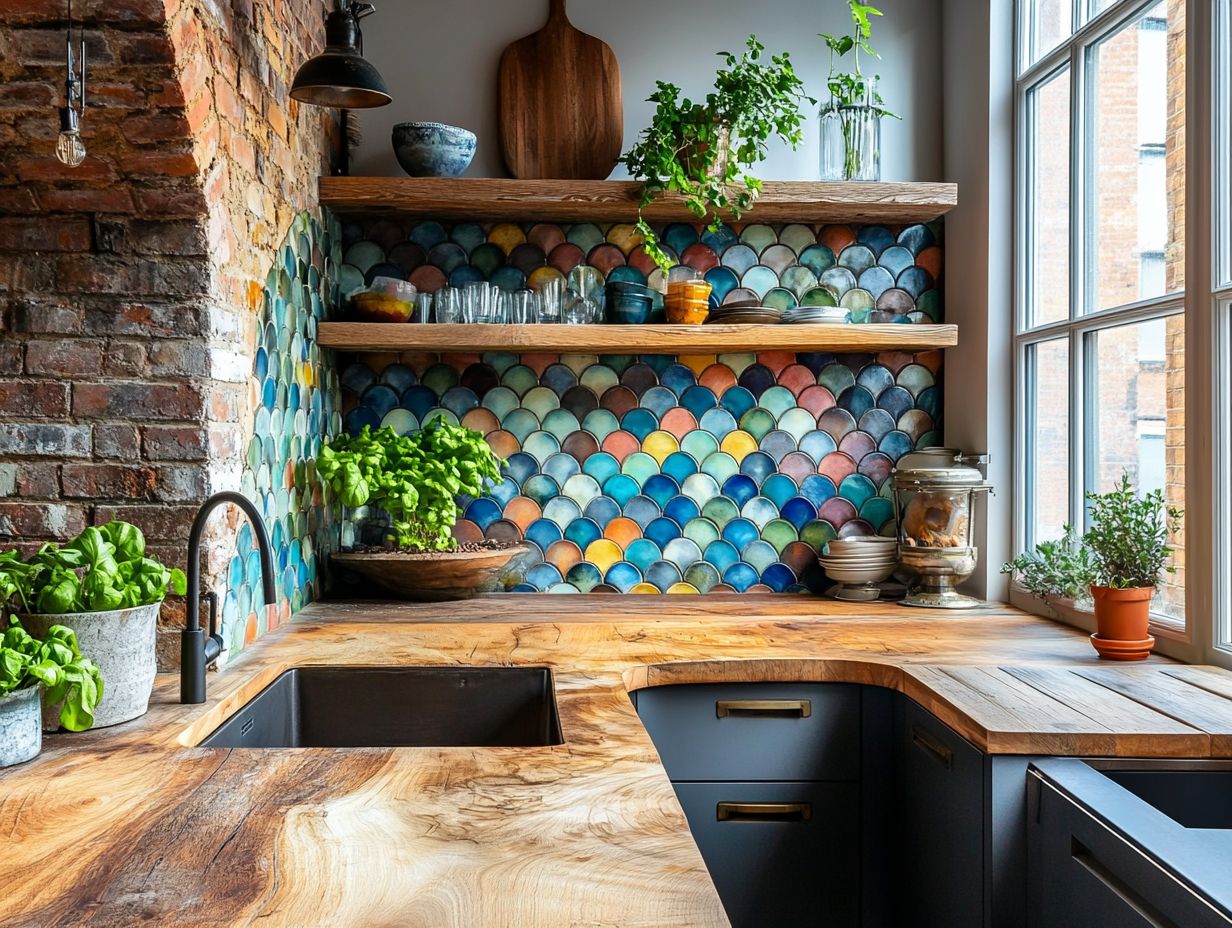
Unconventional materials like concrete, recycled glass, and reclaimed wood add unique design elements to your kitchen.
These materials are good for the environment, durable, and have a lower carbon footprint compared to traditional materials.
When incorporating unconventional materials, consider their maintenance and compatibility with other design elements for a cohesive look.
1. Concrete
Concrete is quickly becoming a sought-after choice for your kitchen redesign. It offers not only a robust and durable surface but also the opportunity to integrate eco-friendly practices and sustainable materials into your design.
This chic and modern selection suits the contemporary kitchen perfectly.
This versatile material can be molded into various shapes and finishes. You can seamlessly blend it with a range of design styles, from minimalist to industrial.
By incorporating recycled aggregates or sourcing from a local concrete supplier, you can elevate your green efforts. When paired with energy-efficient appliances, concrete balances functionality with sustainability.
Don’t miss the chance to add vibrant accents, like colorful cabinetry or striking light fixtures, to invigorate those hard surfaces!
Unique backsplash options, such as textured concrete tiles or colorful mosaics, can enhance visual interest, letting you infuse a personalized touch that breathes life into the space.
2. Recycled Glass
Recycled glass isn’t just an eco-conscious choice; it’s also a stunning option for your kitchen backsplash. It effortlessly combines style and sustainability, enhancing the aesthetics of both modern and traditional kitchens.
This innovative material minimizes waste while adding a unique artistic flair to your kitchen.
By incorporating recycled glass into your backsplashes, you can create dazzling visual effects with shimmering colors and diverse textures, turning an ordinary wall into a captivating focal point.
Imagine showcasing recycled glass in your light fixtures, where it casts vibrant reflections that interact playfully with the surrounding elements, enhancing your ambient lighting while remaining environmentally friendly.
When paired with eco-friendly countertops crafted from sustainable materials like bamboo or recycled wood, the integration of recycled glass creates a harmonious design that beautifully balances function with a responsible approach to your home decor.
3. Reclaimed Wood
Incorporating reclaimed wood into your kitchen design not only brings warmth and character but also champions eco-friendly practices by utilizing secondhand materials that reduce waste and lessen environmental impact.
This distinctive material carries a rich history. Each piece tells a story that makes your kitchen more inviting and personal.
Beyond its aesthetic appeal, reclaimed wood is incredibly versatile; it can be expertly crafted into cabinetry and durable countertops that complement sleek, modern appliances.
The natural variations in color and texture create a stunning contrast with stainless steel and glass, seamlessly bridging the gap between rustic charm and modern elegance.
By choosing reclaimed materials, you help minimize the demand for new lumber, fostering a more sustainable approach to home renovation.
Explore local sources for reclaimed wood to find unique pieces that enhance your design!
4. Stainless Steel
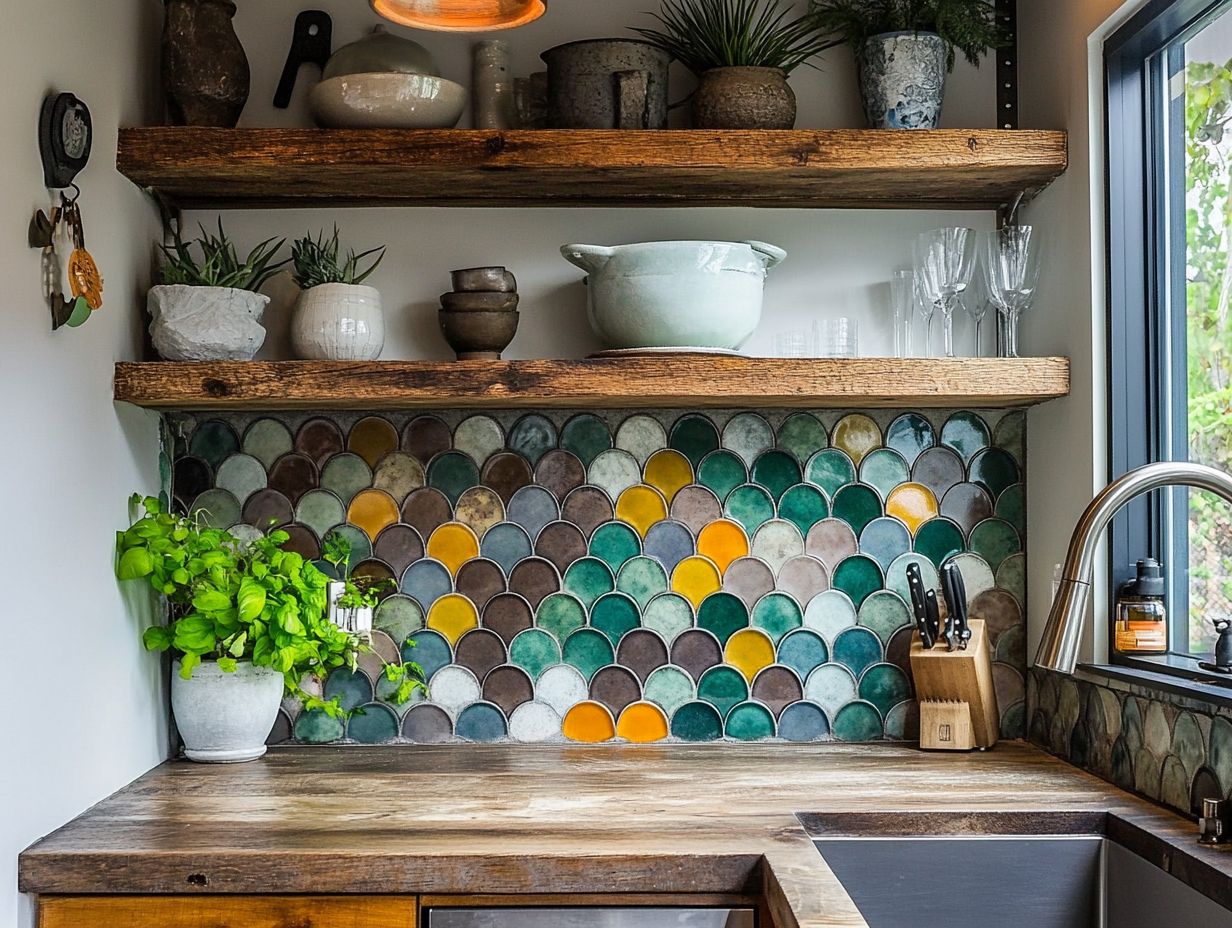
Stainless steel is a timeless choice for your kitchen design, admired for its durability and sleek visual appeal. When paired with energy-efficient appliances and elegant light fixtures, it elevates the overall ambiance of a modern kitchen.
Its reflective surface adds a touch of sophistication and makes the space feel more expansive and open. This versatile material harmonizes with various design elements, from minimalist to contemporary, serving as the perfect backdrop for unique light fixtures that can act as statement pieces.
You can infuse color into the space by incorporating vibrant dishware, colorful kitchen linens, or decorative elements that beautifully contrast with the stainless steel.
By thoughtfully blending these elements, you can craft a kitchen that not only functions efficiently but also radiates your unique personality and style.
5. Cork
Cork stands out as an innovative, eco-friendly material that brings a unique texture and visual appeal to your kitchen designs. It offers sustainable flooring and cabinetry options that enhance energy-efficient lighting and overall kitchen functionality.
It helps keep your kitchen warm in winter and cool in summer, minimizing the need for excessive heating or cooling. This not only elevates your comfort but also contributes to lower energy bills.
Cork pairs beautifully with various other eco-friendly materials, like bamboo and reclaimed wood. Together, they create a stylish and responsible blend.
When you combine cork surfaces with energy-efficient appliances, you can achieve a cohesive design that showcases your commitment to sustainability. The versatility of cork gives you the power to personalize your spaces while making environmentally conscious choices.
Why Should You Consider Using Unconventional Materials in Your Kitchen?
Exploring unconventional materials in your kitchen redesign opens up a realm of design possibilities. These choices not only elevate the visual appeal but also champion sustainability through eco-friendly practices that resonate with modern living principles.
By incorporating materials such as bamboo, recycled glass, or reclaimed wood, you achieve a distinctive blend of durability and style. For instance, bamboo is exceptionally strong and grows rapidly, making it a truly renewable resource.
Recycled glass countertops offer a touch of sophistication while minimizing waste. They perfectly complement energy-efficient designs and harmonize beautifully with green technology.
By selecting unconventional materials, you’re not just creating a stunning space; you’re also embodying eco-friendly values that foster a deeper connection with nature.
What Are the Benefits of Using These Materials?
The advantages of incorporating unconventional materials in your kitchen are abundant. You’ll enhance sustainability and energy efficiency while creating a unique aesthetic that distinguishes your space.
Choosing reclaimed wood allows you to significantly reduce your carbon footprint while savoring the warmth and character that repurposed materials bring. Each piece often carries a rich history, adding a storytelling element to your design.
Incorporating recycled glass into your countertops or backsplashes elevates both insulation and style. You can enjoy vibrant color choices and textures that give your kitchen a contemporary flair.
Embracing these materials leads to substantial energy savings and cultivates an inviting atmosphere that showcases your commitment to eco-conscious living.
Imagine the warmth and character of reclaimed wood bringing your kitchen to life! Start your kitchen redesign today for a fresh and eco-friendly look!
What Are the Potential Drawbacks of Using These Materials?
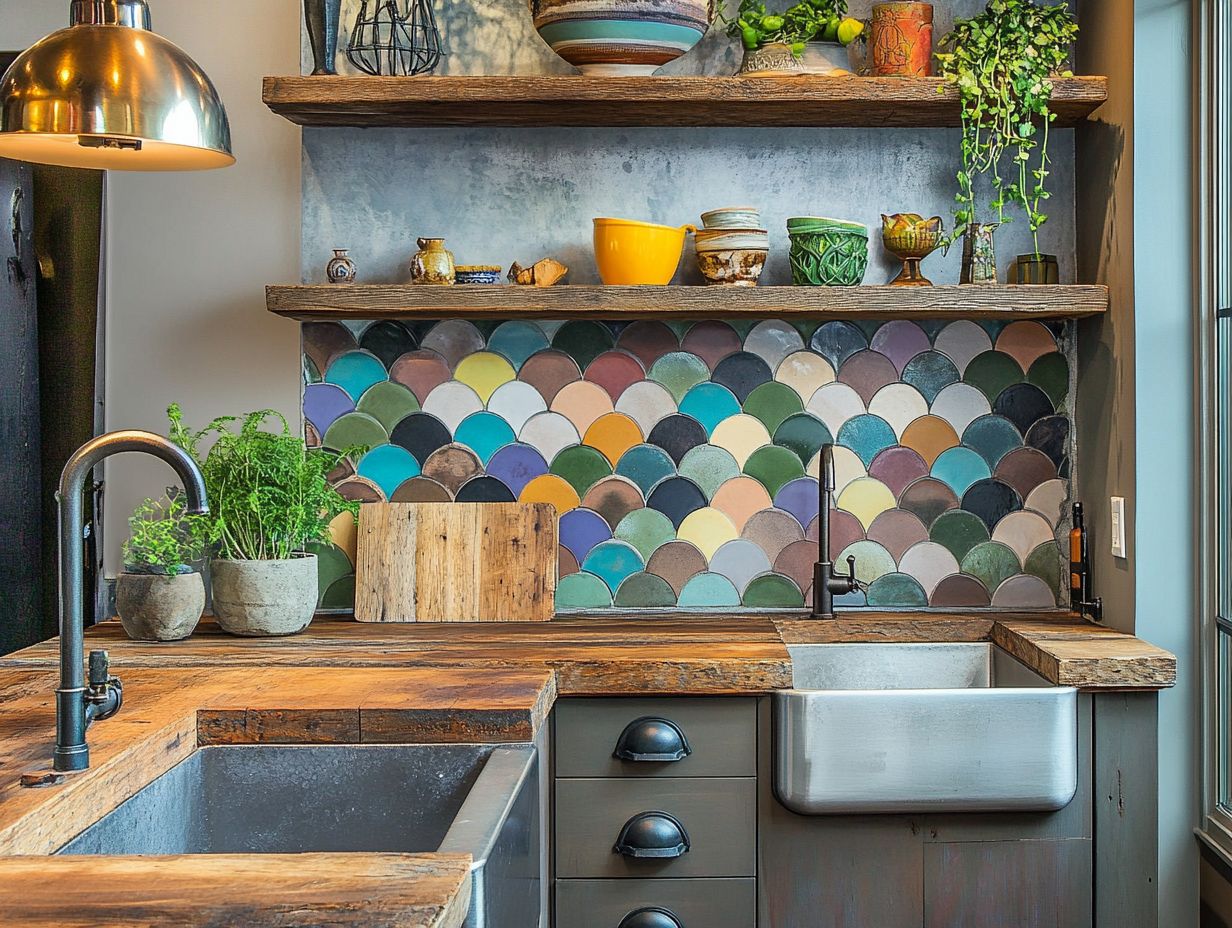
While unconventional materials can refresh your kitchen design, consider the drawbacks: maintenance, cost, and durability. These factors matter when choosing materials.
Take concrete surfaces, for example. They offer a sleek, modern appeal, but they often require sealing and regular upkeep to ward off stains and cracks.
Reclaimed wood can infuse your space with warmth; however, it may struggle with moisture and pests, necessitating careful attention and treatment.
Similarly, while stainless steel delivers a contemporary vibe, pesky fingerprints and scratches can detract from its shine. This means you’ll need to clean it frequently.
Ultimately, you should weigh these factors against the unique charm and character these materials can bring to your kitchen.
How Can These Materials Add Unique Design Elements to Your Kitchen?
Incorporating unconventional materials into your kitchen can transform it into a canvas for unique design elements. This enhances aesthetics and allows your creative expressions to shine through. Imagine adding pops of color, distinctive backsplashes, and innovative light fixtures that reflect your personal style.
For example, using reclaimed wood for cabinetry brings warmth and character into the space. Sleek concrete countertops offer a stunning modern contrast. Vibrant tiles can serve as striking backsplashes, incorporating captivating patterns that add depth and intrigue to your kitchen.
Adding metal accents—like brass or copper—into your fixtures and hardware introduces a touch of glamour. These materials beautifully harmonize with painted cabinetry to create a balanced, dynamic environment. By thoughtfully combining these elements, you can craft a kitchen that is both functional and a true reflection of your individual taste and creativity.
What Are Some Tips for Incorporating These Materials into Your Kitchen Design?
Incorporating unconventional materials into your kitchen design demands thoughtful planning and a dash of creativity. Focus on harmonizing these elements with your existing decor while prioritizing eco-friendly choices and sustainable practices.
To achieve this balance, consider using reclaimed wood or reused metals as unique accents. These materials elevate your space’s aesthetic without compromising sustainability. Pairing these choices with energy-efficient appliances will enhance the harmony of your design, ensuring that form and function are seamlessly integrated.
When selecting materials, prioritize sourcing from local vendors. This supports community businesses and helps reduce carbon footprints. Look for certifications that prove sustainability. This way, your kitchen renovation will be stylish and a meaningful step toward reducing your environmental impact.
What Are Some Examples of Kitchens Using These Unconventional Materials?
Many modern kitchens highlight the innovative use of unconventional materials. Stunning reclaimed wood cabinetry and sleek recycled glass backsplashes transform the space. These choices captivate the eye and contribute to an eco-friendly kitchen environment.
Consider a recent kitchen renovation where the countertops were crafted from upcycled Corian. This material features a unique, speckled pattern and helps reduce landfill waste, demonstrating a commitment to sustainability.
Bamboo flooring has surged in popularity due to its rapid renewability and robust nature. It brings a warm aesthetic that doesn’t compromise ecological values. Such design choices resonate with homeowners like you, who seek to blend functionality with environmental consciousness.
You can absolutely have style and sustainability together in your kitchen!
Frequently Asked Questions
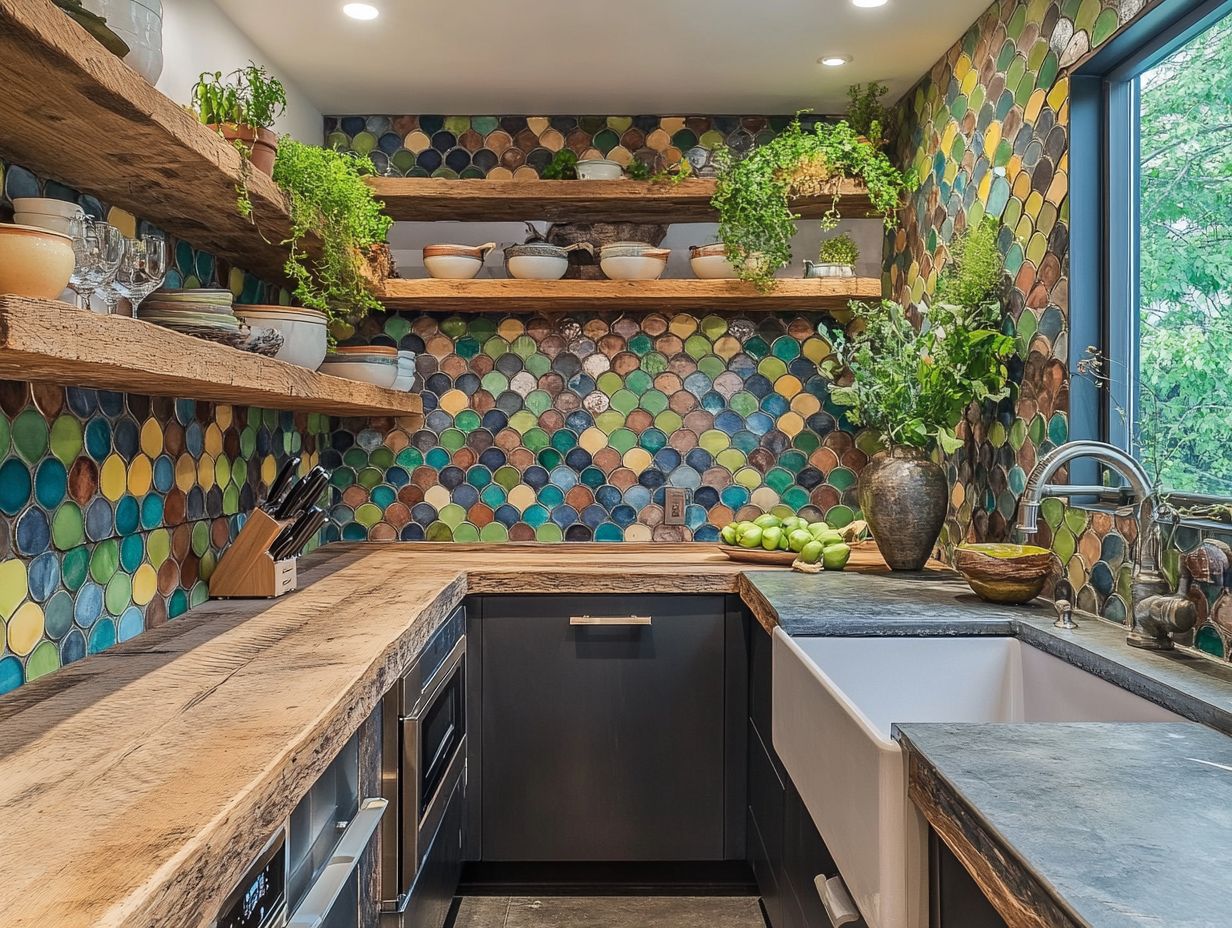
What are some of the unconventional materials used in kitchen design?
Some unconventional materials used in kitchen design include concrete, reclaimed wood, metal, glass, and cork.
How can concrete be used in kitchen design?
Concrete works beautifully as a countertop, flooring, or accent wall. It gives a modern, industrial vibe to any kitchen.
What makes reclaimed wood a unique material for kitchen design?
Reclaimed wood is eco-friendly and adds warmth to your kitchen. Use it for countertops, cabinets, or backsplashes.
In what ways can metal be incorporated into kitchen design?
Metal fits perfectly for appliances, fixtures, and countertops. It brings a sleek, contemporary look to your space.
How can glass be used in a kitchen design?
Glass makes a stunning choice for cabinet doors and backsplashes. It adds elegance and creates an illusion of more space.
What makes cork a suitable material for kitchen design?
Cork is renewable and resistant to heat and moisture. It’s great for flooring, countertops, and even wall coverings.
Explore these materials to create a kitchen that reflects your style. From the industrial feel of concrete to the warmth of reclaimed wood, the choices are endless!
